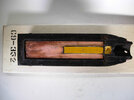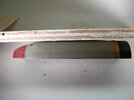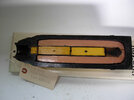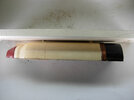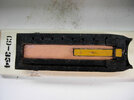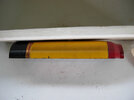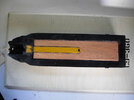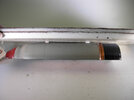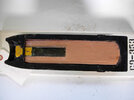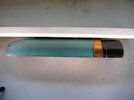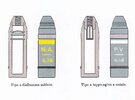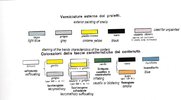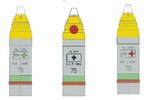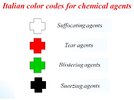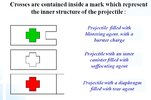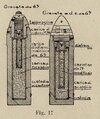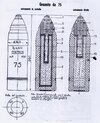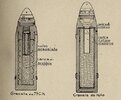British Ordnance Collectors Network
You are using an out of date browser. It may not display this or other websites correctly.
You should upgrade or use an alternative browser.
You should upgrade or use an alternative browser.
Italian Projectiles
- Thread starter jvollenberg
- Start date
wingsofwrath
Well-Known Member
Interesting. While these are definitely Italian projectiles for the 65/17 M.1908, 75/27 Krupp M.1906 and the 76/40 M.1916, the colours, especially on the chemical shells are not the ones I would have expected.
For reference, here is how the Italian gas shells should be painted - first plate is WW1 including key, second is interwar and WW2, also with key.
For reference, here is how the Italian gas shells should be painted - first plate is WW1 including key, second is interwar and WW2, also with key.
Attachments
Last edited:
Most of the stuff at Aberdeen seems to be repainted, but these don't seem to be. I am not sure if they are 100% correct. Hard to tell honestly.
Joe
Joe
The colour codes and inner structure slides you posted are interesting. Do you have a reference? CheersInteresting. While these are definitely Italian projectiles for the 65/17 M.1908, 75/27 Krupp M.1906 and the 76/40 M.1916, the colours, especially on the chemical shells are not the ones I would have expected.
For reference, here is how the Italian gas shells should be painted - first plate is WW1 including key, second is interwar and WW2, also with key.
Do you have the nomenclatures for each of them by chance?
Joe
Joe
wingsofwrath
Well-Known Member
Unfortunately, I can't remembrer where I found them, because it was on some forum years ago. Reverse searching the image gives no hits. So that's all I have, sorry.The colour codes and inner structure slides you posted are interesting. Do you have a reference? Cheers
Yeah, if these are all HE and one CA, then the colours start to make sense if we assume the pre-1942 colour scheme - the "grigio chiaro" (light grey) body stood for "granata ordinaria d’acciaio" (ordinary steel shell) the white body was for "granata a grande capacità" (large capacity shell) and the "bigio azzurrino" (light blue) body was for "granata a frattura prestabilita" (pre-segmented shell) while a "rosso carminio" (carmine red) ogive denotes incendiary filling - I assume it's that and not a "rosso minio" (minium red) ogive denoting "caricamento da guerra" (war loading) since that one's more orange.
Couldn't find any info on the CA shell, but if we assume they had yellow bodies and the red ogive denotes incendiary filling, this would explain why the 76/40 M.1916 anti-aircraft shrapnel shells in Romanian service were yellow (in Romania, shrapnels were usually red, with yellow deonoting HE filling) because this was the colour they came in from italy and they were never repainted...
Last edited:
Hello,
There is a little confusion in Italian color code.
1932 regulation assures shell are grey. If loaded red Orange ogive.
Green band for steel shell
Dark red BAND shrapnell
Black band cast iron
White band high capacity
Blue band antinaircraft.
Here 65/17 and 75/27 shells
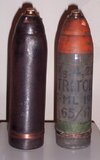
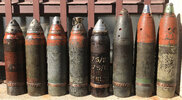
Antinaircraft shell 75/27 CA and 76/40
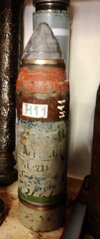
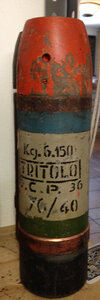
There are variations in pre 1932 and restored shells (ex ww1 shells and shrapnell)
Here a ww1 shrapnel (red) restored in 30’s with red ogive and a shrapnel restored with 1932 color code.
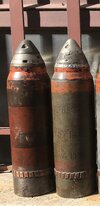
There is a little confusion in Italian color code.
1932 regulation assures shell are grey. If loaded red Orange ogive.
Green band for steel shell
Dark red BAND shrapnell
Black band cast iron
White band high capacity
Blue band antinaircraft.
Here 65/17 and 75/27 shells


Antinaircraft shell 75/27 CA and 76/40


There are variations in pre 1932 and restored shells (ex ww1 shells and shrapnell)
Here a ww1 shrapnel (red) restored in 30’s with red ogive and a shrapnel restored with 1932 color code.

Last edited:
This color code intended for ww1 stuff. Italian ww1 76/40 shell was with navy color code, white with red ogive. No yellow shells used by italian. I know Italy also made for Romania 47/32 rounds for the 47mm Bolher AT gun, and they were yellowUnfortunately, I can't remembrer where I found them, because it was on some forum years ago. Reverse searching the image gives no hits. So that's all I have, sorry.
Yeah, if these are all HE and one CA, then the colours start to make sense if we assume the pre-1942 colour scheme - the "grigio chiaro" (light grey) body stood for "granata ordinaria d’acciaio" (ordinary steel shell) the white body was for "granata a grande capacità" (large capacity shell) and the "bigio azzurrino" (light blue) body was for "granata a frattura prestabilita" (pre-segmented shell) while a "rosso carminio" (carmine red) ogive denotes incendiary filling - I assume it's that and not a "rosso minio" (minium red) ogive denoting "caricamento da guerra" (war loading) since that one's more orange.
Couldn't find any info on the CA shell, but if we assume they had yellow bodies and the red ogive denotes incendiary filling, this would explain why the 76/40 M.1916 anti-aircraft shrapnel shells in Romanian service were yellow (in Romania, shrapnels were usually red, with yellow deonoting HE filling) because this was the colour they came in from italy and they were never repainted...
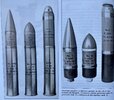
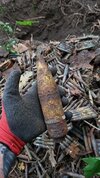
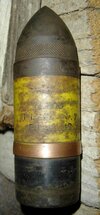
Last edited:
wingsofwrath
Well-Known Member
Yeah, I know, I'm the one who posted those pictures...This color code intended for ww1 stuff. Italian ww1 76/40 shell was with navy color code, white with red ogive. No yellow shells used by italian. I know Italy also made for Romania 47/32 rounds for the 47mm Bolher AT gun, and they were yellow
View attachment 194603View attachment 194604View attachment 194605
And as I said on that thread, the yellow is an oddity for AP shells, because they should have been either unpainted with black ogives or fully black with white writing, but I guess some wires got crossed between the Italian factory and the Romanian government. So I guess it is possible the 76/40 shrapnels were yellow because of the same misunderstanding.
As for the Italian ammunition colour codes, what you show there is the WW2 colouration, which is all "grigio azzurino" bodies with "rosso minio" ogives for war loading and different colour bands, but the colours I gave came from 1928. Here is the whole excerpt in Italian with English translation in brackets and bold:
"Con disposizioni ministeriali emesse nel 1928, i nuovi proietti e quelli di ripristino (materiale residuato della prima guerra mondiale) dovevano essere verniciati come segue: (By the ministerial provision issued in 1928, new production shells and restored ones [residual ordnance from WW1] have to be painted as follows: )
• granata a grande capacità => colore bianco; (high capacity shells - coloured white)
• granata ordinaria d’acciaio => colore grigio chiaro; (ordinary steel shell - coloured light grey)
• granata ordinaria di ghisa acciaiosa e di ghisa => colore grigio scuro; (ordinary semi-steel and cast iron shell - coloured dark grey)
• granata a frattura prestabilita => colore bigio azzurrino; (pre-segmented shell - coloured light blue-grey)
• granata a pallette => colore rosso Dantin; (shrapnel shell - coloured Dantin red)
• proietti da esercitazione, scuola tiro, da esperienza => colore nero; (drill, firing school and practice projectiles - colured black)
• i proietti di preda bellica e quelli forniti dagli inglesi e assemblati con incendivi italiani (spolette, detonatori, ecc.) vennero verniciati con le colorazioni italiane;(captured shells as well as those provided by the British and paired with italian firing devices [fuzes, detonators, etc] will be repainted in Italian colours)
• il munizionamento di preda bellica con incendivi originali veniva verniciato con colori originale; (captured ammunition with original firing devices will be left in original colours)
• il munizionamento inglese con incendivi originali era verniciato in colore kaki; (British ammunition with original firing devices will be painted khaki)
• il munizionamento francese sia con incendivi originali che con incendivi italiani rimaneva verniciato con colori originali francesi. (French ammunition with either original firing devices or Italian ones will remain in original french colours)
per indicare il tipo di caricamento, sull’ogiva si sovrapponeva al colore di fondo la seguente colorazione: (to indicate the type of loading, the ogive will be overpainted in the following colours")
• colore rosso minio (coloured in minium red)
- tutta l‘ogiva: caricamento da guerra (whole ogive: war loading)
- mezza ogiva: caricamento ridotto per scuola tiro (half the ogive: reduced load for schooling)
• colore rosso carminio (coloured in carmine red)
- tutta l’ogiva: caricamento incendiario (whole ogive: incendiary filling)
- mezza ogiva: caricamento illuminante (half the ogive: illumination filling)
• colore nero (coloured black)
- tutta l’ogiva: caricamento fumogeno (whole ogive: smoke loading)
- metà ogiva: proietto munito di tracciatore (half ogive: projectile with tracer)
• colore giallo (coloured yellow)
- tutta l’ogiva: caricamento a liquidi speciali (whole ogive: loaded with special liquids [gas])
Per tutti i proietti a cartoccio (proietto unito al bossolo) la parte sottostante la corona di forzamento sera verniciata in nero d’asfalto." (For all fixed ammunition [projectile joined with the casing] the part under the rotating band will be painted asphalt black) - which, you will note, is the same same as the German shells, also painted in "Asphaltlack" under the rotating band while French shells etc. were laquered.
Last edited:

